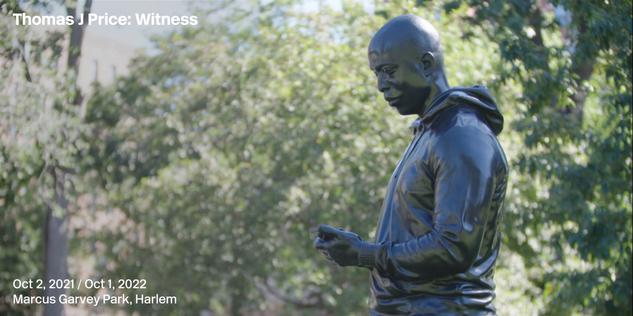Thelma Golden: Kahlil, tell us about how you make what you make.

Kahlil Robert Irving: This project consists of wallpaper, digital collage print on paper, ceramic sculptures made out of objects from my studio, and handmade pressed ceramic tiles. There are a couple of works on aluminum panel, vinyl adhered to panel, and vinyl adhered to MDF panel. Then another series of images on aluminum panel. The images on the wallpaper range from photographs to movie stills and television shows, to the information I’ve sourced on Google Images, including flags, historical quilts, and images of protests in response to events occurring in St. Louis. There are also images of my family and AI or CGI-built environments of cities or landscapes. There’s a lot of pixelization, a lot of repetition, and a lot of different colors. The data of all this imagery creates an experience of navigating physical and immaterial spaces that can coexist simultaneously.
Most of this work grew from visiting New York City for the first time in 2011 when I was a freshman in college. I’d never been on a plane before and when I looked out from the airplane, I saw how the roads partitioned the earth. I flew over lower Manhattan and into Queens and the experience of seeing the vertical structures protruding from the Earth’s surface was inspiring. So, I made these drawings that conflated the verticality of the buildings and the horizontality of the partitioned land. Then I drew a constructive perspective merging the two. I’m constantly taking one thing and blending it or forcing it to live with another. Making ceramics look like something else from life comes from that first experience of making these constructed perspective drawings in 2011.
I’ve been making things out of clay since I was 12 years old. At first, I didn’t necessarily think what I was doing was making art; I thought of myself as a student learning a process: managing the clay, throwing it on the wheel, trimming the dried-out clay to make it more refined, then processing the material. The sculptures in this installation also have the residue of this experience—of becoming a student of the material and stewarding it through its myriad capabilities or means of existence. The images applied to the surfaces are a more recent experience of learning what’s possible.
Some of the works on panel were a part of other installations, which is a reference to the feedback loop. I scan images back into the computer, as a way of bringing where I’ve been into where I’m going. I reuse photos taken by relatives as a means to re-encapsulate not only someone else’s energy but my own energy and experience as well.









